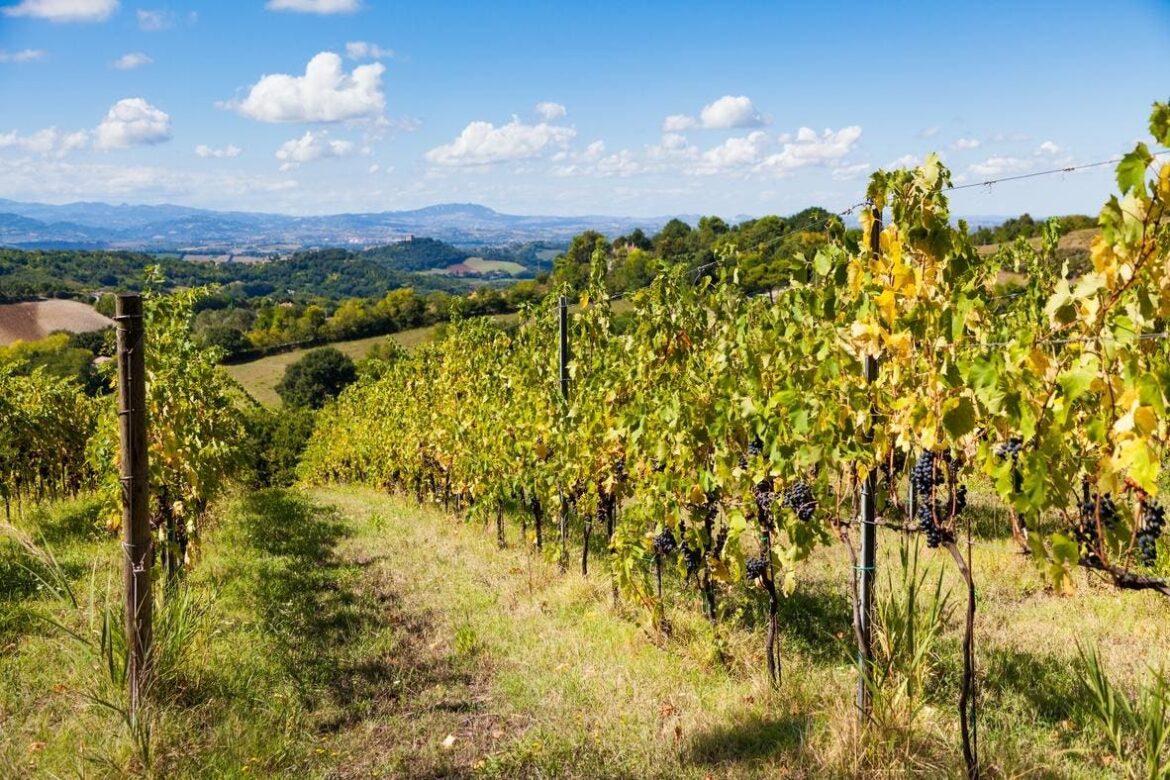
Panorama view over the hillside in Romagna.
getty
On a recent trip to Emilia-Romagna, often viewed as the bread basket of Italy, one thing was clear: the two regions have nothing culinarily to do with each other. Lambrusco rules the roost in Emilia while Romagna is more about seriously food-friendly Sangiovese and acidic and fruit-forward whites.
While this region borders Tuscany, the area’s style of Sangiovese is much lighter, less tannic and food-friendlier. While the Albana di Romagna, a native grape, has solid acidity is seems to have so much less than some Tuscan Vermentinos produced in the region next door.
Many of the wine styles were totally unique to me, so I sat down with Filiberto Mazzanti, the director of the Consorzio Vini di Romagna to get his take on the wines. All responses have been edited and condensed for clarity.
Liza B. Zimmerman (L.B.Z.): What is truly unique about the wines of Romagna?
Filiberto Mazzanti in Romagna.
Consorzio Vini di Romagna)
Filiberto Mazzanti (F.M.): Romagna wines come from an extraordinarily diverse land, suspended between the sea and the hills, where the Adriatic Sea softens the climate and the Apennine Mountains create major temperature swings.
This dual climatic influence gives the wines natural balance, freshness and aromatic depth. Each Romagna wine tells the story of a generous land, rich in biodiversity and rural culture, where the bond between people and vineyards remains deeply rooted.
L.B.Z.: What are the area’s top grapes and how have they changed over the years?
F.M.: Sangiovese represents the red soul of Romagna, grown on almost every hillside, while Albana represents the region’s white identity and has the pride of being Italy’s first white grape to earn DOCG status in 1987.
A seminar during a recent conference on the wines of Romagna.
WellCom and region of Romagna
Over the past decades, Romagna’s wine scene has majorly evolved: producers have moved from large-scale, quantity-driven production to a more quality-focused approach that values terroir, soils and microclimates. Today, most wines highlight specific crus and subzones, focusing on native grapes and sustainable farming practices that enhance fruit purity and regional character.
L.B.Z.: How is the region’s Sangiovese different from its Tuscan neighbor?
Emilia-Romagna on the map of Italy in soft grunge and vintage style, like old paper with watercolor painting.
getty
F.M.: Sangiovese from Romagna tends to be more fruit-forward and approachable than its Tuscan cousin. The region’s proximity to the sea and its calcareous-clay soils produce wines that are juicer with softer tannins and lively acidity.
It’s a Sangiovese that favors elegance over power, drinkability over structure. While Tuscan versions are often more austere and long-lived, Romagna’s Sangiovese stands out for its aromatic brightness and freshness: often making it more versatile at table yet able to age beautifully over time.
L.B.Z.: How does the area’s maritime influence affect the region’s wines?
F.M.: The Adriatic Sea has a major impact on Romagna’s microclimate. It’s a relatively warm inland sea, yet its breezes moderate the summer heat and help grapes ripen more slowly and evenly, preserving natural aromas and acidity. The resulting wines have great balance, freshness and a subtle, salty edge that hints at the sea.
L.B.Z.: What are typical food pairings for Sangiovese and how do they differ from those in Emilia or Toscana?
F.M.: Romagna Sangiovese is perfect with the region’s hearty and flavorful cuisine. Beyond the classics like tagliatelle al ragù and piadina—a local sandwich wrap—with cured meats and cheeses, or grilled meats, it also pairs surprisingly well with seafood.
Piadina romagnola, italian flatbread sandwich
getty
Compared to Tuscany, where Sangiovese often pairs with more structured and spiced dishes, or Emilia, where the rich cuisine—such as tortellini in broth, lasagna and boiled meats—calls for softer or sparkling wines such as Lambrusco, Romagna sits in between. The more saline Sangiovese, produced in Romagna, moves easily between land and sea being equally at home with egg pasta dishes or a delicate fish course.
L.B.Z.: How has the smaller size of many of the local producers affected the style of the wines produced in the region?
F.M.: The abundance of small, family-run wineries has shaped the region’s winemaking style. Romagna’s growers’ smaller scale also tends to encourage bold choices—from organic farming to spontaneous fermentation—that help to build the wines’ distinctive identities.
L.B.Z.: Where do you think the region is headed?
wooden barrels crammed into an underground cellar for wine aging in Valpolicella soft light in warm tone backlight closeup with blurry background and soft light
getty
F.M.: Romagna is home to a new generation of producers who combine technical knowledge, aesthetic sensitivity, environmental respect and innovation. The future lies in further highlighting individual crus, embracing sustainability and strengthening the region’s international visibility. Increasingly, Romagna aims to stand out as one of Italy’s most dynamic wine regions as a place where quality is born from respect for nature, a deep passion for the craft and a strong, distinctive sense of identity.


Dining and Cooking